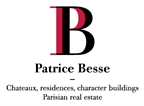A majestic, early 20th century manor house, its outbuildings and more than 7 ha of parklands, overlooking the Seine estuary near to Trouville - ref 53
A majestic, early 20th century manor house, its outbuildings and more than 7 ha of parklands, overlooking the Seine estuary near to Trouville.
This property stands on a hillside along the "Côte de Grâce" (Coast of Grace) between Trouville and Villerville. It is 400 m from the sea as the crow flies and looks out over the Bay of the Seine River. Paris is 200 km away via the A13 motorway or 1½ hours from Deauville train station, just 10 minutes by car.
Whether from the main gates or from those near to the garages, two driveways go around the property to the manor house. The first goes alongside the caretaker's cottage, whilst the second goes, in the opposite direction, around a large farm building, an outbuilding in use as a garage as well as a workshop and along a double row of beech trees to reach to the other side of the manor house. Set between these two driveways, the garden slopes gently down towards the sea. The wooded slope behind the manor house goes up to the top of the hillside.
The manor houseConstructed at the very beginning of the 20th century, this rectangular manor house spans three levels. Its architecture is composed of numerous protrusions. A central projection is flanked, on the corners of the main facade, by a round tower and by a square aedicula. Behind, a rectangular, 2-storey extension has been added to one corner. A square construction comprises an impressive porch, looked down on by a loggia in the middle of the rear facade. And lastly, a semi-engaged, half-timbered extension on a gable goes up to the second level.
Just like the facades, the roofs vary in shape and size. A candlesnuffer roof tops the round tower, others are composed of two, three or four slopes, whilst that crowning the central projection has five, very steep slopes topped with a bell-tower. And all are covered with flat tiles. Some are softened with upward curving eaves and others are enhanced with tall, dressed stone and brick chimney stacks as well as shed and Jacobin-style dormers.
The variety of the architectural features is spectacular. The walls of the first level are a succession of geometric motifs composed of dressed stone, flanking quarry stone blocks and black or white flint, forming strips, squares and chessboard patterns. Dressed stone comprises the surrounds framing the openings which are geminated, casement or half-casement and sometimes flanked by tall, richly sculpted pinnacles. Arches are triangular, semi-circular or basket-handled in shape. Arch moulding is supported on bases decorated with foliage.
The upper levels are half-timbered, featuring diagonal ties and cross braces. The second level features corbelling. On one section of the main facade, angle braces support a gallery and a balcony. Some trusses overhang.
Everywhere, in every section, new details appear.
The ground floor
The entrance door is housed in the central projection. It opens into a majestic hall, paved with ceramic floor tiles, the motifs of which appear to be taken from a Renaissance bestiary. Four, fluted stone columns support a cloister arch vault with brick and dressed stone domes. The stone walls are richly adorned with decor, such as pilasters, scrolls and mascarons. A majestic, wooden stairway faces the entrance door. Its carved newel post can but bring the mermaid of a ship's figurehead to mind. The hall leads on either side to a lounge and a dining room, an access to the cloakrooms, a hallway and the basement.
The vast, bright lounge is laid with herringbone pattern parquet flooring. A sober fireplace is made of marble, an arched opening leads to an area in the tower, the ceiling features arch moulding, adorned with cornices. Double doors, glazed with mirrors, open into a study where wood takes pride of place, comprising a fireplace, strip pattern parquet flooring, wainscoting as well as ceiling ...


